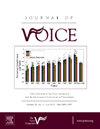声带褶皱白斑病的滚塑与微瓣切除术比较
IF 2.5
4区 医学
Q1 AUDIOLOGY & SPEECH-LANGUAGE PATHOLOGY
引用次数: 0
摘要
研究目的本研究的目的是比较声带白斑(VFL)的复发率和嗓音改善情况,具体方法是单独进行微瓣切除术或单独进行射频(RF)Coblation:方法: 研究对象为术中接受单纯微瓣切除术或单纯射频消融术治疗的声带白斑患者。比较两组患者的复发率、嗓音评估和视频曲速镜图像:微瓣切除术组术后 12 个月的复发率为 37.7%(26/69),Coblation 组为 7.7%(4/52),差异显著(P < 0.05)。两组患者术前和术后的主观检测数据显示存在显著差异,但与微皮瓣切除术组相比,Coblation 组恢复得更好。术后未发现肉芽组织增生或前会厌粘连等与Coblation相关的并发症:结论:在声带白斑患者中,与微瓣切除术相比,射频消融术的复发率更低,嗓音改善效果更好。本文章由计算机程序翻译,如有差异,请以英文原文为准。
Comparison Between Coblation and Microflap Resection of Leukoplakia of the Vocal Fold
Objectives
The objective of this study was to compare the recurrence rate and voice improvement of vocal fold leukoplakia (VFL) between microflap resection alone or radiofrequency (RF) Coblation alone.
Methods
Patients with VFL intraoperatively treated via microflap resection alone or Coblation alone were enrolled. The recurrence rate, voice assessment, and Videostroboscopic images were compared between the two groups.
Results
The recurrence rate at postoperative 12 months was 37.7% (26/69) in the microflap resection group and 7.7% (4/52) in the Coblation group; the difference was significant (P < 0.05). The preoperative and postoperative subjective detection data from the two groups showed significant differences, but the Coblation group recovered better compared to the microflap resection group. No Coblation-related complications were found, including postoperative granulation tissue hyperplasia or anterior commissure adhesion.
Conclusions
In patients with vocal cord leukoplakia, RF Coblation had a lower recurrence rate and better voice improvement compared with microflap resection.
求助全文
通过发布文献求助,成功后即可免费获取论文全文。
去求助
来源期刊

Journal of Voice
医学-耳鼻喉科学
CiteScore
4.00
自引率
13.60%
发文量
395
审稿时长
59 days
期刊介绍:
The Journal of Voice is widely regarded as the world''s premiere journal for voice medicine and research. This peer-reviewed publication is listed in Index Medicus and is indexed by the Institute for Scientific Information. The journal contains articles written by experts throughout the world on all topics in voice sciences, voice medicine and surgery, and speech-language pathologists'' management of voice-related problems. The journal includes clinical articles, clinical research, and laboratory research. Members of the Foundation receive the journal as a benefit of membership.
 求助内容:
求助内容: 应助结果提醒方式:
应助结果提醒方式:


